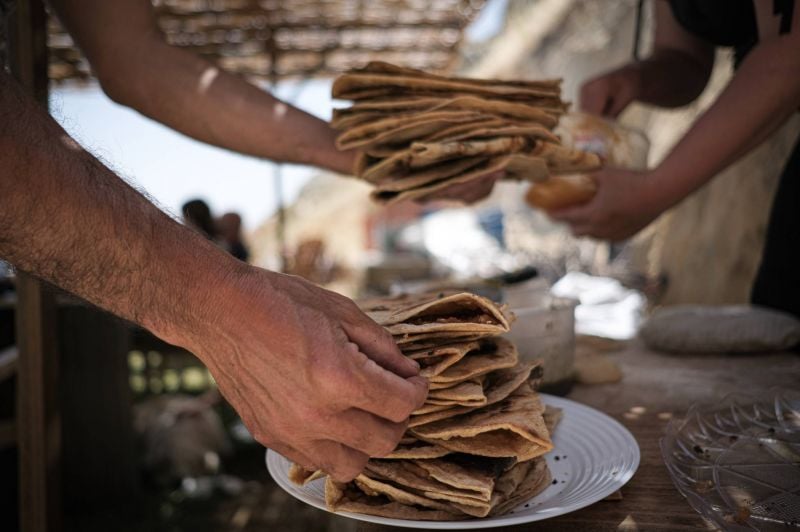
Manaeesh, fresh from the furn. (Credit: João Sousa)
BEIRUT — Everyone loves manaeesh. Practical, varied, delicious, and filling, manousheh is one of those foods that comes packed with nostalgia, and there is good reason for that.
Whereas Baklawa’s origins are exclusive, palatial, and fancy, the manousheh finds itself on the opposite end of the spectrum. It is the food of the people. In today’s urbanized Lebanon, it is treated as a street food staple to be enjoyed at any time of the day, but especially in the early morning for breakfast rituals and sobhiyet (morning gatherings).
Before receiving “street food” status, long before Lebanon even existed as a state, the common manousheh was a thing of villages, prepared by rural women.
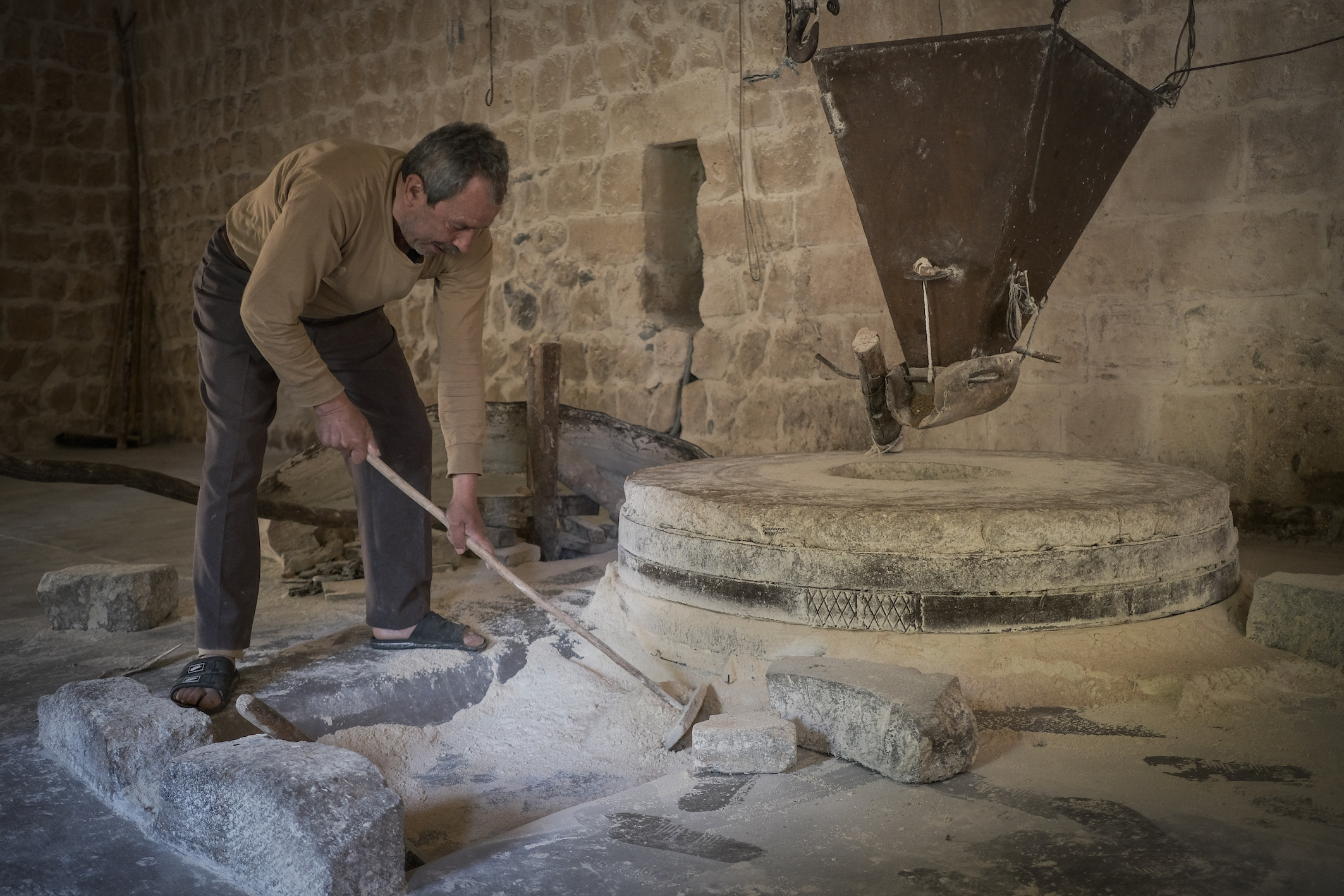 Ahmad hydro-milling flour in Hakkour, Akkar. (Credit: João Sousa)
Ahmad hydro-milling flour in Hakkour, Akkar. (Credit: João Sousa)
‘Ken 3enna tahoun’
It is impossible to talk about manousheh without first talking about bread. It is, after all, bread — with a topping.
Bread itself originated in the Middle East and is believed to be tens of thousands of years old. Archeologists have traced bread as far back as 12500 BC in Jordan and 8000 BC in Egypt.
Then, as now, the base of any bread is flour.
In Lebanon back in the day, water-powered mills, which historians believe were invented by the Romans in 450 BC, were commonly used to crush grain into flour. This is echoed fondly in the age-old song in which Fairouz famously sings “ken 3enna tahoun 3a nab3 el may” (long ago we had a mill on the river).
Only a handful of traditional water-mills still exist in the country today, and even fewer are functional.
On the banks of the Orontes River (Nahr al-Assi), in the tiny village of Hakkour in Akkar, there sits a hydro mill that still generates wheat flour (for manaeesh), fine burghul, and corn flour. Over 400 years old, the mill is owned by the Nasr family, who purchased it from Ottoman officials in the 1920s.
Nasser Nasr, the current manager of the family property, explains to L’Orient Today that for hundreds of years, “people of the area would grow their own grain and bring it to the mill to be ground into flour.”
Today, the mill is operated by Ahmad, whose father ran the mill before him.
“We fear that after Ahmad, there will be no one to keep the mill running,” says Nasr, himself a lawyer.
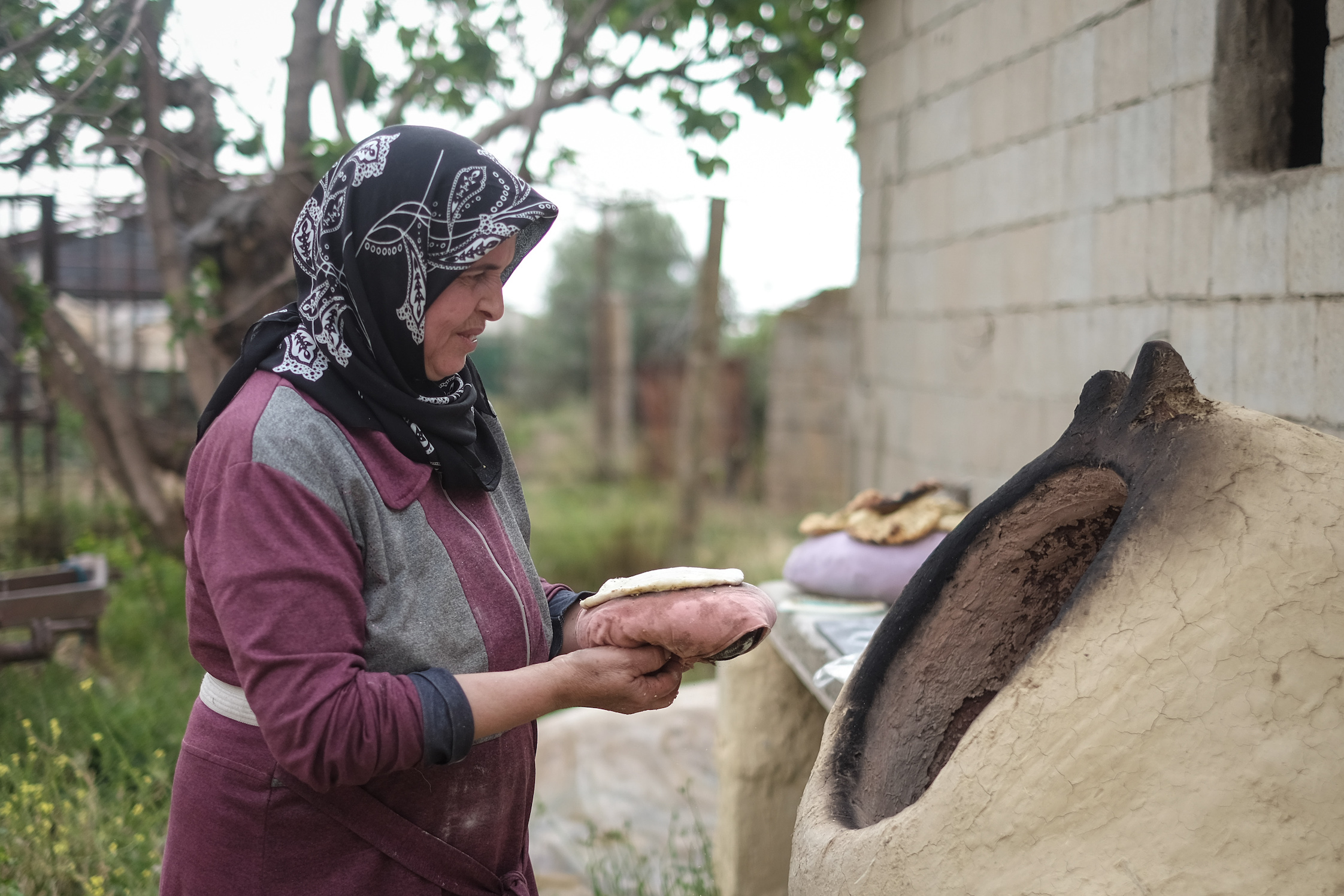 Kara in hand, Randa mart Ali prepares to slap dough to the inside of her tannour. (Credit: João Sousa)
Kara in hand, Randa mart Ali prepares to slap dough to the inside of her tannour. (Credit: João Sousa)
Preparation
Mix flour with water, salt and maybe a leavening agent, and you have dough.
Before the advent of modern gas ovens, people would bake flat bread on a saj (a small griddle oven), in a tannour (a clay oven), or in a brick fire oven.
“In rural areas it was mostly the job of women to make bread,” says American historian Sara Pekow.
“In the countryside, people had their taboun or tannour ovens outside their homes. These were clay ovens with an open hole, you would make a fire inside and stick the bread to the side of the wall,” she explained.
The tannour dates back over 5000 years to the Indus Valley civilizations.
Heated by an internal (typically wood) fire, the word tannour comes from the Akkadian (ancient Mesepotamian) “Tinuru,” a conjunction of the words tin (mud), and nur (fire) — the same words for mud and fire in Arabic!
Randa mart Ali from Idlib, Syria, who lives in Akkar where her husband tends a plot of land a few miles away from Hakkour, keeps the ancient bread-making tradition alive.
She kneads balls of dough, stretches them out on a kara (bolster), generously coats them with zaatar (thyme), and slaps them onto the sides of a heated tannour.
Making tannour bread is still the norm back home in Idlib, she says. In Lebanon, this tradition has nearly become an artifact of the past. It is rare to find the occasional tannour joint in some unexpected corners.
“Every four or five families in a neighborhood would share a tannour,” recalls Randa. “To keep old bread fresh later in the week, you would wet it with water to make it malleable again.”
Perhaps more common than the tannour today is the saj, which was also commonly used in antiquity. Less communal than the tannour, it was widely used in individual households, and by pastoralists (nomadic shepherds).
“Bedouins would use a saj because they could pick it up easily and take it to the next location,” Pekow remarked.
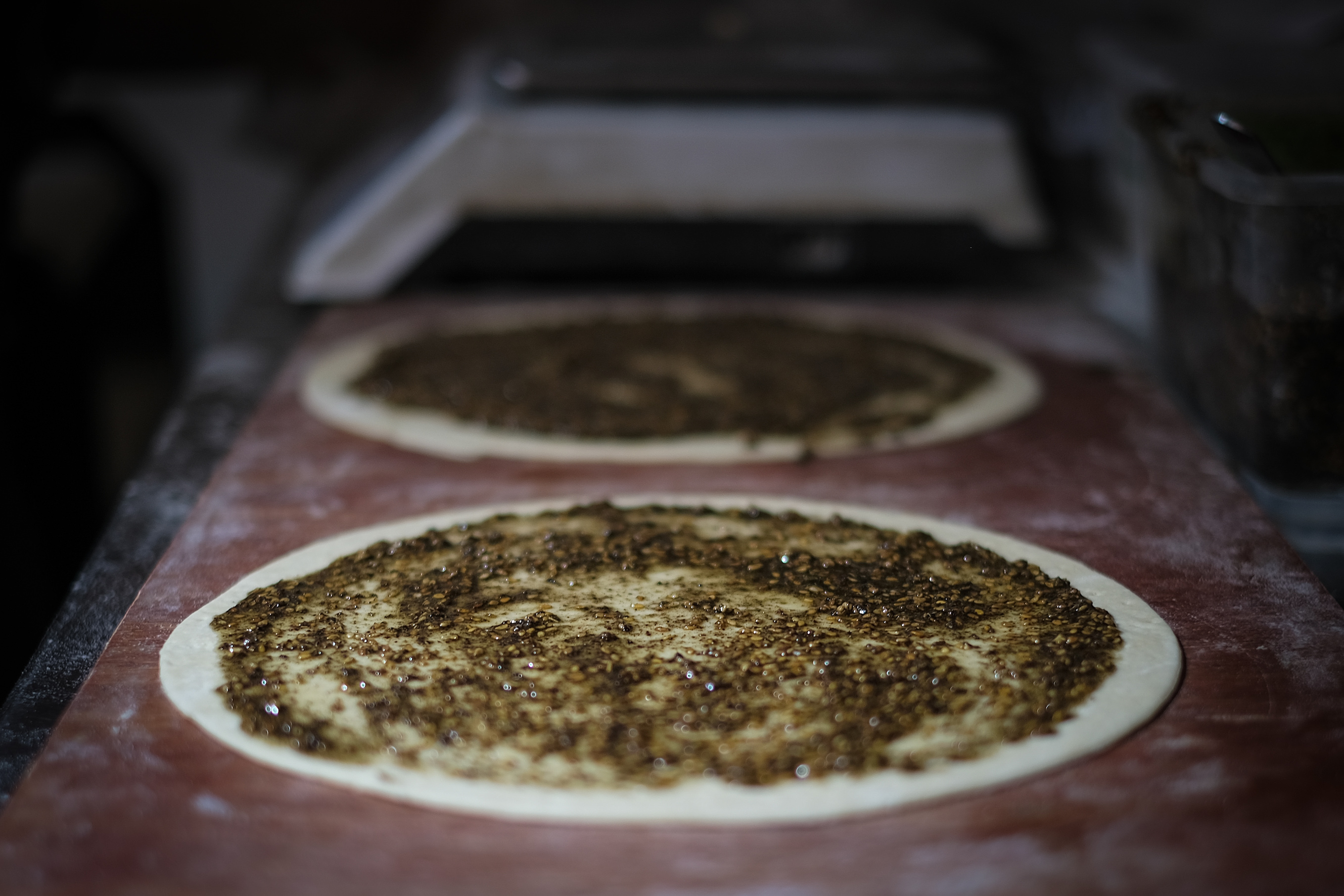 Manaeesh ready for baking. (Credit: João Sousa)
Manaeesh ready for baking. (Credit: João Sousa)
A rural, communal tradition
Kamal Mouzawak, founder of Souk El Tayeb, a social enterprise working to preserve culinary and rural heritage, recounts a story that echoes the core reason the manousheh came into existence in the first place.
“My grandmother had 10 kids. And she had to make a huge quantity of bread for the entire family once a week. Because they were a poor family and they only had a saj, she would spend the whole day making bread.”
“What can she feed her kids [during] that day spent making bread? Something simple and easy, that’s what. Zaatar, with a bit of sumac, salt and [sesame seeds]. She’d spread the simple ingredient mix on the bread she was making, and voila. The meal of the day.”
Mouzawak’s grandmother did what countless women before her also did: Across the region, women would — often in communal fashion — dedicate a full day to making enough bread to last their family a week. This often meant they had no time to make their family lunch. On bread-making days, adding a topping to fresh baked bread was the easiest thing to whip up.
The manousheh was born — in the rural Levant, out of convenience.
Its inherent deliciousness is what kept it alive through the ages, preserving it from obscurity.
It migrated to the city alongside people of rural areas. The communal aspect of bread making remained.
“In the cities, you could either buy bread from a bakery or take your dough to a communal oven to be baked,” said Pekow.
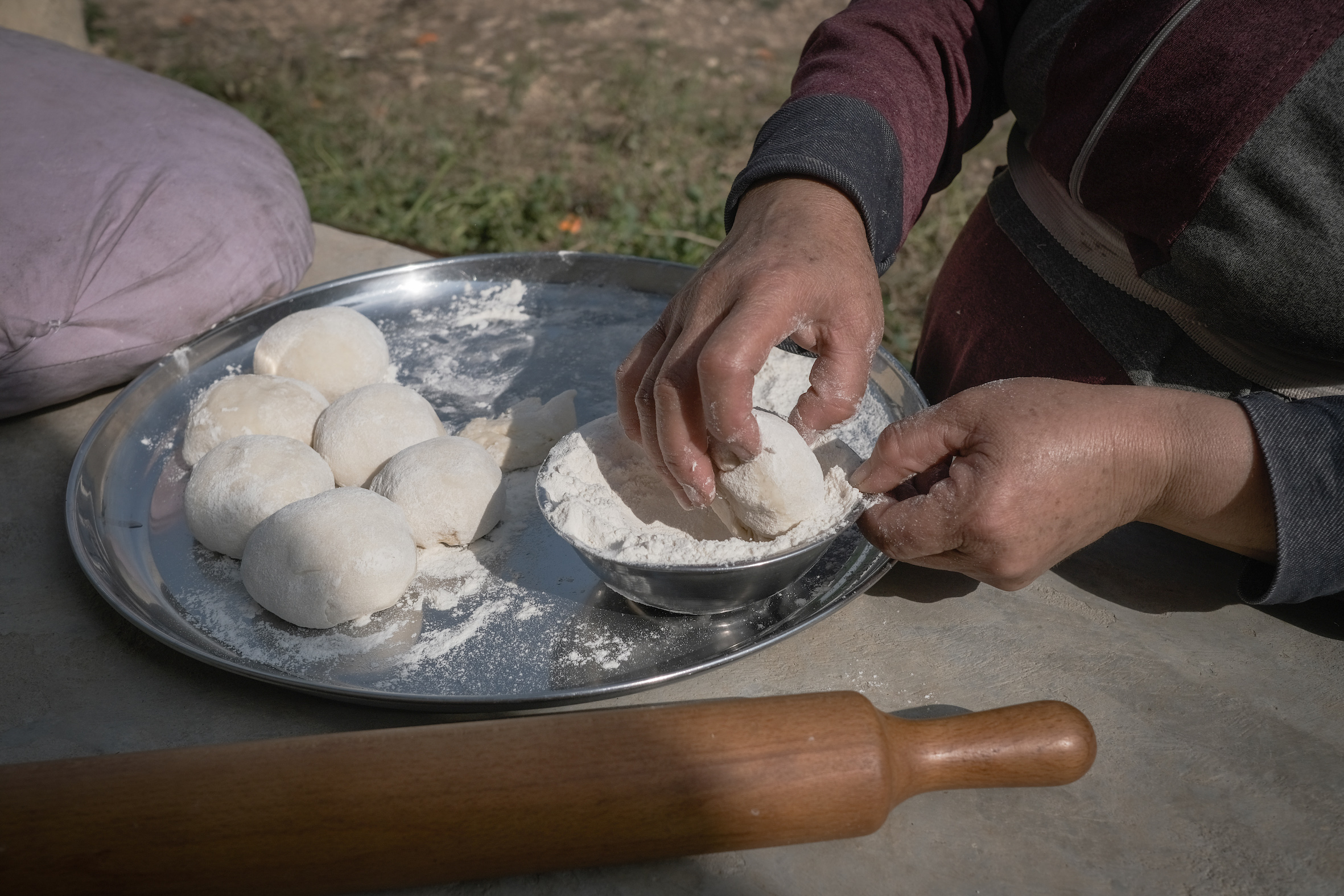 Randa mart Ali prepares dough for a batch of tannour-baked manaeesh near Hakkour, Akkar. (Credit João Sousa)
Randa mart Ali prepares dough for a batch of tannour-baked manaeesh near Hakkour, Akkar. (Credit João Sousa)
Today
Buying ready-made manaeesh is a relatively new concept.
“Buying manousheh came during war times,” remarks Mouzawak, now in his 50’s.
“As a kid, your mother would send you to the communal neighborhood furn [oven] down the street and you would take your own zaatar with you, secured in an empty [sweets] container. You’d return home with a heaping pile of warm, freshly baked manaeesh in your arms, of course crowned with the now empty [sweets] container.”
Neighborhood ovens, where you can bake your own manaeesh, and confections like maamoul, are still common across the country.
The classic manousheh is traditionally topped with zaatar mix, or keshk (fermented dairy and burghul). Besides sesame seeds, which came by way of the silk road, zaatar, sumac and olive oil were all ingredients in local abundance.
There’s one way to separate Lebanese city dwellers from rural folk that Mouzawak swears by:
“Ask them if they like keshk, they will either react in disgust … ‘niah2. What’s that smell!’” he half-jokes. “In that case, you know they’re from the city. Otherwise, they worship keshk. In which case, you know they’re from the mountains or the Bekaa.”